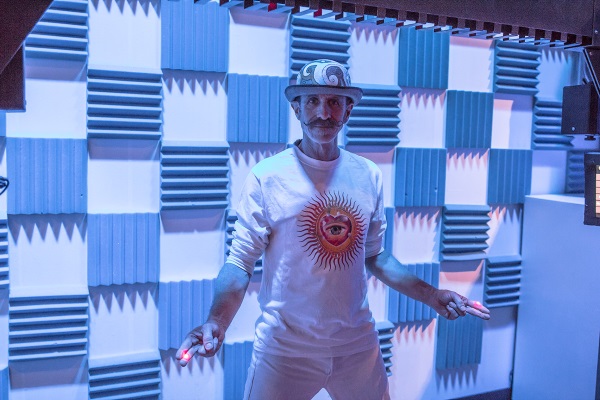Home > Home - Featured
11/27/2015
An Alchemy of Sound: The Transformative Power of Johnny Dwork's Laser Harp Alembic
By Aaron Martin //
"With the development of this laser harp, DJ's can break free from the confines of staring at a tiny computer while performing. Now we can play music by dancing with light."
How often do we see an evolution of the way music is created and experienced? Imagine an instrument with which you can play an endless variety of sounds without the use of a laptop. Now imagine it's smart enough that a perfect amateur can make it sound good with relative ease, yet the same device is customizable to be challenging for the professional musician. Even more intriguing, you play this instrument by dancing with it. Just such a device exists, and it's closer than you think. It's called the Laser Harp Alembic–or L'HA for short–and it's currently on exhibit at OMSI. We paid the Laser Harp a visit to find out from L'HA's creator, Johnny Dwork. Johnny is an author, political/environmental activist, empowerment facilitator, special events and theater producer, and musical visionary.
Tell us about yourself, Johnny.
My primary life mission is to create transformative peak experiences, immersive art environments and, overall, participatory culture. As such, I'm always on the hunt for unusual art that encourages participation, regardless of age, culture, or level of skill. My company, Peak Experience Productions, specializes in producing events that support the 'experience economy' – in other words, participatory culture.
By participatory culture, you mean a richer experience than simply staring at a dj on a stage for two hours.
While traditional dj entertainment does have its place, projects like this laser harp strive to dissolve the boundary between performer and audience. I also strive to present transformative experience that shifts consciousness through clever play.
What inspired you to undertake the L'HA project?
Cross-pollination. I was at Burning Man, where I go every year. 2015 was my 19th consecutive Burn. The primary reason I go to Burning Man is to experience art that inspires me, and to meet artists with whom I can collaborate. I encountered a laser harp out there.
When was this?
Oh, maybe a decade ago. Other laser harps, what they usually do is trigger a cheesy sounding synthesizer or drum machine to play single notes or chords in a chromatic scale. The result is that these other laser harps sound pretty awful when played by non-musicians, which is discouraging for both the player and listener.
Just as with traditional musical instruments, there's a steep learning curve with these other laser harps.
That's right. There's not much for people who aren't accomplished musicians to grab onto. So I was playing with this old style Laser Harp, and I realized there's technology out there now that would allow you to transform this type of device so that it plays loop-based music, dance music that actually sounds great. After I had this epiphany, I contacted a laser harp artist and we worked together to create the first version of this Laser Harp.
How many versions have there been?
This is version 3.0. Each time, we literally stripped the device down to it’s bare bones and started rebuilding from the ground up.
Ok, let's get technical for a moment. Walk us through the device.
L'HA is essentially a large, sculptural, three-sided computer keyboard…sort of like three electronic synthesizers fused together…except that each of the notes on the keyboards are beams of laser light. As participants dance through the sculpture, they interrupt these lasers – the same low-powered lasers that are used in supermarket UPC barcode scanners.

The lasers shine down into the same type of light sensors that are in the security lights outside your house that turn the outside lights on and off when you walk past them. When each light sensor is interrupted it sends a signal, through a computer language called MIDI, to a computer hidden in the machine that's running a software program called Ableton Live. This software controls a mind blowing array of custom-built sounds and parameter changes.
Explain Ableton Live for us.
Ableton Live is one of the primary programs that big djs or music programmers are using when they're playing up on stage at a nightclub or a festival. The dj creates their music in this software and then uses it to manipulate different parameters during live performance: to segue back and forth between different soundtracks, to add sound effects such as reverb and delay, to make parts of the music go backwards or forwards, or to pan parts of the music from left to right.
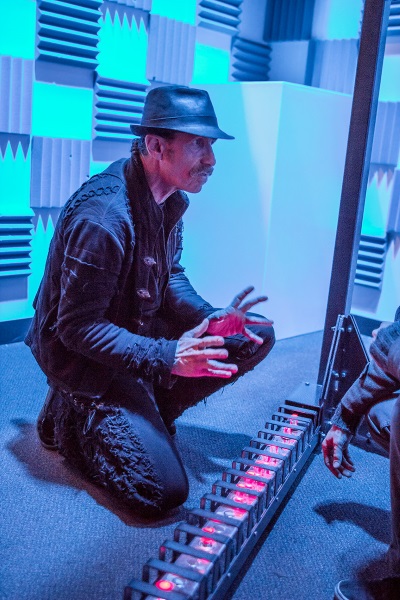
So, while I was playing that old style laser harp at Burning Man, I began to realize I could program a laser harp so it would accomplish several very exciting breakthroughs in music experience. First, with this software we can assign the lasers to control not just single notes, but also loops of complex sounds and also all the parameter changes. With the development of this laser harp djs can break free from the confines of staring at a tiny computer while performing. Now we can play music by dancing with light. I also realized that we could enlist this software’s ability to “quantize” the music, which allows the music to all play perfectly in time…so a three year old could make music that sounds good even though they don’t understand music theory.
How is the Laser Harp Alembic different from, say, those controllers that Glitch Mob bang around on during their show?
Glitch Mob tilts their control devices so the audience can watch them work the knobs that control the music…much better than staring at the back of a tiny computer, right? The Laser Harp does this same thing, but you manipulate light beams instead of rotating knobs.
Johnny demonstrates. He chooses 'Drum Circle' from the Harp’s multi-song jukebox control panel and takes a ready stance in the center of the triangular L'HA. He darts a hand outward. A drum loop begins to play the instant his hand crosses one of the laser beams. He sweeps his other hand over a different group of lasers in a back-and-forth motion, creating a series of staccato beats. Tentatively, we join in from outside the Harp. We start hitting different lasers, exploring. The way L'HA is laid out, we have to reach this way and that in order to add different melodies and beats. Soon we're dancing in order to keep the loops and sounds going, using our whole bodies to create music. And although we've never met and we're playing keys at random, what's produced is a remarkably pleasing melody.
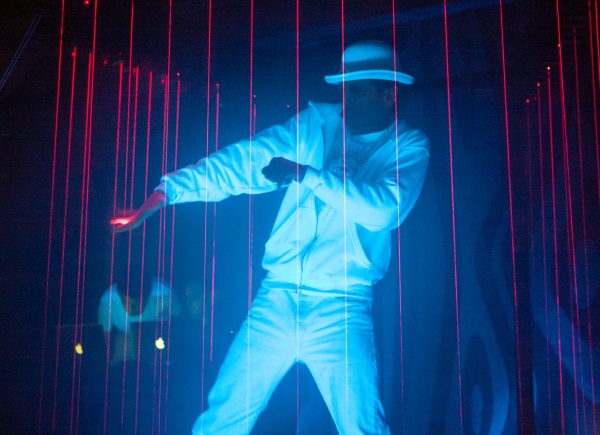
As Johnny plays different notes, he explains:
The laser harp was intentionally designed to be both mysterious and uncommonly easy to use. Its lack of obvious instructions naturally encourages exploration and experimentation. And yet, we can set the operating system to make sure that every sound it plays is both in tune and in time. Think about that for a minute. This means that people from anywhere on the planet, regardless of age or musical skill set, can instantly play music with one another that sounds completely awesome. We’ve also arranged the lasers in different groupings, so that participants are naturally prompted to make sounds that compliment one another. Without any prior practice, users can “scratch” recordings of Hip Hop records or manipulate the “wobble” in Dubstep music like an experienced dj.
Johnny changes the menu to something called “Spoken Weird.” The keyboards now trigger a new set of sounds in the form of voices, hoots, laughs, and so on. There's also a setting for Dubstep, Trap, Downtempo Ambient and House music, but these presets are just a demo of what the Harp can do. Johnny explains that all these menu settings are for Museum Mode, whereas Pro Mode allows for a far richer range of customization and manipulation for the professional musician.
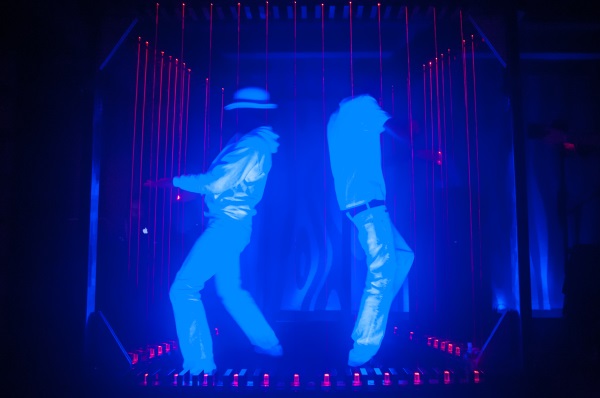
Where did all these sound profiles come from?
My team created every sound on the laser harp. Art Drots, a brilliant, young, Portland-based, music producer–otherwise known as DJ MyMind–is our lead programmer and music producer. He's been the 'wunderkind' here.
So these sounds were curated you and him.
Yes, most of the vocal sounds and instruments that you hear on the harp were played by Portlanders, with the exception of one voice provided by a young Dutch girl during her first visit to America.
What's amazing to see in action is how people can play all these keys seemingly at random, and it's really hard to mess it up. How did you manage this feat?
A lot of effin' work! The biggest challenge with this project has been to make it that it doesn't sound like crap when people just start triggering all the lasers at random or at the same time. This cutting edge music production software now allows us to instruct the computer to listen to everything being played and to gently shift the sounds so that they all play in time with one another. The computer manages 36 channels that are each running many different sounds and sound effects simultaneously. It then divides the unaffected sounds so that you hear them playing out of the monitor speaker closest to the player’s ear but then adds all the special effects on speakers away from the player’s ear. The other biggest challenge was to do all of this without crashing the computer.
From all the intense, real-time processing?
Yeah. We have, at any given moment, hundreds of commands that are being triggered. And all of the different soundscapes are in one single session. It's been nothing short of a miracle that we've been able to create this powerful of an experience with all of those parameters being met. The reason it’s called a laser harp “alembic” is because the harp is a lot like the alchemist’s flask…a sturdy crucible in which greatness is manifest through careful experimentation.
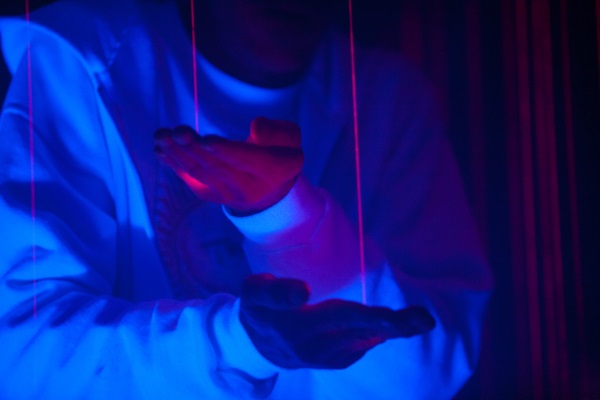
What have you observed when people first play with L'HA?
When people play the harp, they start to giggle, they start to experiment, they naturally move in such a way that they're all of a sudden interacting with people. This is one of the things that turns me on. It's my mission in life. People expect a music or art experience to be a certain way. I enjoy exploring outside the frame…and inviting others to think and act expansively, differently, experimentally. People come in and they see the Harp, and it's not playing. Then they trigger a sound and exclaim, “Whoa!” Sometimes they'll literally jump in delight! Then you see them go through this exploratory process. It just naturally makes them inquisitive. It's something outside of their normal experience that naturally intrigues people to be curious. To explore. And they tend to do it together. Without instructions. That “aha!” moment really turns me on: to witness people making art when they did not think they had it in them.
Yet the learning curve, at least initially, is not steep. It's easy to jump in, hard to master.
Correct. It’s exciting to be on the leading edge of the “Social Music Technology” movement that is harnessing technology so that it empowers people of lesser musical talent to feel the thrill of making complex and coherent music.
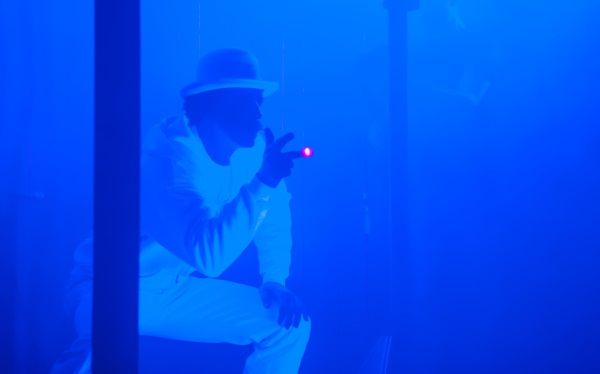
It allows us to interact through music as a universal language.
It's a way that people can have the expressive experience of music flow through them, so they get the hit, the juice, that more accomplished musicians let's say would. Which hopefully then would inspire them to get more into music and do the much more challenging work of learning music. I wish I had that growing up…I might have gotten into making music much sooner.
The possibilities for customization here are vast, from the numerous ports on the device, to the software itself, and all the ways that people can manipulate it at a festival, a museum, or onstage.
This project isn’t just about empowering neophytes. There's a sweet spot in the programming here. We have endeavored to make a device that simultaneously captivates someone who doesn't understand the first thing about music and also professional music producers. It seems that we've been successful with that. This device also allows professional djs to step away from staring at the computer and start controlling their music by dancing through the laser beams. In that sense, synesthesia – the blending of the sense – begins to occur. We start to hear movement.
How does it feel to look back on all the effort required to get this complex project to the point at which it is touring museums.
It's so exciting for my team and I, because this device has become a laboratory. It pushes us against our limits in a field of research that explores creating social music technology. How do I create devices and experiences that bring people together, that give people different types of musical experiences or sound experiences that they have direct access to? And so the Laser Harp is a laboratory where we're constantly being challenged by pushing the technological bounds and the limitations of cultural expectation.
After all it's taken you and your team to get here, that must be very rewarding.
We feel we've been successful in that original vision in essentially creating a form of social music technology. I'm really excited by the adaptation of technology that provides artistic and immersive musical experience for people. They become one with art or music regardless of their skill set or level of mastery.
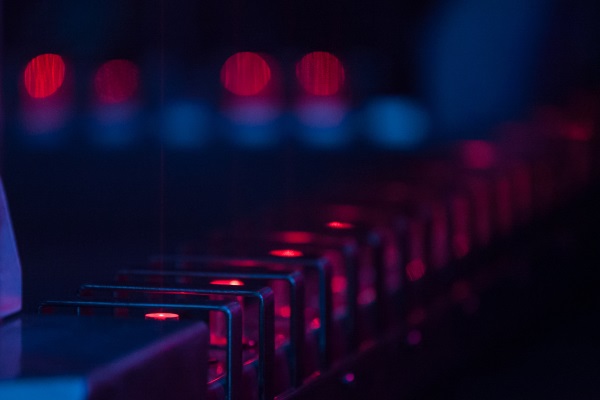
The laser harp is on display at OMSI through January 10th, 2016. For more info explore:
Images provided by:
Ryan Rammage



